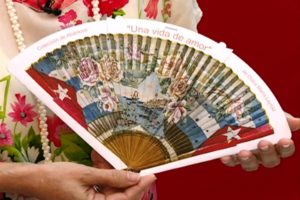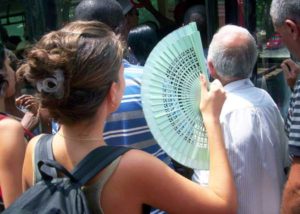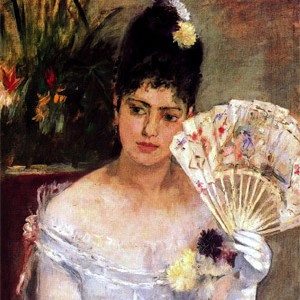“THE ABANICO” IN CUBA AND ITS USE NEEDED AND NEVER FORGOTTEN.
The Abanico returns to fashionable in Havana. Ladies, already a certain age they never left. But now it is increasingly seen among the young women who, along with the cell phone, incorporate it to their accessories. Tradition and modernity together in the same bag. Not only is it a propitious gadget to scare away the heat, it also accompanies and adds a special touch to feminine coquetry.
Yesterday’s Cuban woman lived in great fanfare. The best and, therefore, more expensive, were those that when opened and when closed they heard a click that was almost a detonation. And with what surprising skill they managed to convey a message. Because there is a language of fans in which our predecessors were well versed.
A well-designed fan is capable of transmitting a minimum of thirty-six messages. It enabled communication between lovers in a time when the meeting alone of two who sympathized with each other was almost unthinkable. The fan was then a secret weapon. Thus, if a lady passed her index finger by the rods of her fan, she indicated to her lover that she was urging him to say something to her, and if the hair was removed from her forehead with the patterns, the message was almost a plea, asking her not to Forget The thing became ugly for the lover if the lady fanned herself with her left hand because she was jealous and if she did it very slowly, the message was tantamount to indifference.
Nothing is the fans, says Eusebio Leal, Historian of Havana, if not a woman’s hand in a gesture of soft caress, hidden flush, propensity, haughtiness, contempt, temptation.
The origin of the fan is lost in the night of time. It was commonly used, among certain social strata, in ancient Egypt about 3000 BC. Then, we will find it in Etruscan, Greek, Roman and Chinese representations, of course. In America it was known before the arrival of the Spaniards, for the Emperor of the Aztecs, among others present, congratulated Cortes with six feather fans. By then Columbus had given one of these pieces to Queen Elizabeth the Catholic. It appears in the hands of the slaves in the mural paintings of pharaonic tombs, accompanies the Roman Caesars and, in the processions, the pontiffs of the Church …
However, and even if there is no record of it, the first fan was much earlier. He made the man with leaves of trees or palms, just as they do today, with the finely woven fiber, men of the field.
It was always rigid fans. The folding or rod fan appeared in Japan in the 7th century. He was created by a merchant from that country after carefully observing the beating of the wings of a bat. That is why it was called komori, Japanese word that identifies that batsman. A good day spread throughout Europe, came to Spain in the fifteenth century, but it was not until the nineteenth century when in Valencia began a major production and export-oriented. There are very fine and expensive, made with black lacquers and paintings of pure gold, and also of silver, ivory and pearly shells, and there are the very popular and current, made in series,
Whose manufacturing is so cheap that politicians and commercial houses can incorporate them into their promotional campaigns.
In the funds of the City Museum, in the Palace of the Captains General of Havana, an impressive collection of fans. It goes from 1850 to 1900. Precious pieces and exquisite taste.
In these days of hot summer, Cuban youth have remembered that the fan exists. And even if they do not speak their language and know nothing of the clicks with which their grandmothers knew how to open and close it, their use makes them more elegant and attractive.
“EL ABANICO” EN CUBA Y SU USO NUNCA OLVIDADO Y NECESARIO.
Vuelve a ponerse de moda en La Habana el abanico. Señoras ya con cierta edad no lo abandonaron nunca. Pero ahora se ve cada vez más entre las jóvenes que, junto con el teléfono celular, lo incorporan a sus accesorios. Tradición y modernidad juntas en el mismo bolso. No solo es un adminículo propicio para espantar el calor, sino que acompaña y añade un toque especial a la coquetería femenina.
La cubana de ayer vivió entre grandes golpes de abanico. Los mejores y, por tanto, más caros, eran los que al abrirse y al cerrarse dejaban escuchar un chasquido que era casi una detonación. Y con qué sorprendente destreza lo manejaban para transmitir un mensaje. Porque hay un idioma de los abanicos en el que fueron muy versadas nuestras antecesoras.
Un abanico bien esgrimido es capaz de transmitir un mínimo de treinta y seis mensajes. Posibilitaba la comunicación entre los enamorados en una época en que el encuentro a solas de dos que se simpatizaran mutuamente era casi impensable. El abanico fue entonces un arma secreta. Así, si una dama pasaba el dedo índice por las varillas de su abanico indicaba a su enamorado que le urgía decirle algo, y si se retiraba el cabello de la frente con los padrones, el mensaje era casi una súplica pues le pedía que no la olvidara. La cosa se ponía fea para el amante si la dama se abanicaba con la mano izquierda ya que estaba celosa y si lo hacía muy despacio, el mensaje equivalía a indiferencia.
Nada son los abanicos, dice Eusebio Leal, Historiador de La Habana, si no los despliega una mano de mujer en gesto de suave caricia, rubor escondido, seña propicia, altivez, desprecio, tentación.
El origen del abanico se pierde en la noche de los tiempos. Era de uso corriente, entre ciertas capas sociales, en el antiguo Egipto hacia el año 3000 antes de nuestra era. Luego, lo encontraremos en representaciones etruscas, griegas, romanas y chinas, desde luego. En América se conoció antes de la llegada de los españoles pues el emperador de los aztecas, entre otros presentes, congratuló a Cortés con seis abanicos de plumas. Ya para entonces Colón había obsequiado una de esas piezas a la reina Isabel la católica. Aparece en las manos de las esclavas en las pinturas murales de las tumbas faraónicas, acompaña a los césares romanos y, en las procesiones, a los pontífices de la Iglesia…
Con todo y aunque no quede constancia de ello, el primer abanico fue muy anterior. Lo confeccionó el hombre con hojas de árboles o de palmas, tal como siguen haciéndolo hoy, con la fibra finamente tejida, los hombres del campo.
Se trataba siempre de abanicos rígidos. El abanico plegable o de varillas apareció en Japón en el siglo VII. Lo creó un comerciante de ese país luego de observar minuciosamente el batir de las alas de un murciélago. Por eso se le denominó komori, palabra japonesa que identifica a ese quiróptero. Un buen día se expandió por Europa, llegó a España en el siglo XV, pero no es hasta el siglo XIX cuando en Valencia se inicia una producción importante y orientada a la exportación. Los hay finísimos y caros, confeccionados con lacas negras y pinturas de oro puro, y también de plata, marfil y conchas nacaradas, y están los muy populares y corrientes, fabricados en serie,
cuya manufactura se abarata tanto que los políticos y las casas comerciales pueden incorporarlos a sus campañas promocionales.
En los fondos del Museo de la Ciudad, en el Palacio de los Capitanes Generales, de La Habana, obra una impresionante colección de abanicos. Va desde 1850 a 1900. Piezas preciosas y de un gusto exquisito.
En estos días de ardiente verano, jóvenes cubanas han recordado que el abanico existe. Y aun sin que manejen su idioma ni sepan nada de los chasquidos con que sus abuelas sabían abrirlo y cerrarlo, su uso las hace más elegantes y atractivas.
Agencias/Ciro Bianchi/Internet Photos/Arnoldo Varona/ TheCubanHistory.com
THE CUBAN HISTORY, HOLLYWOOD.









